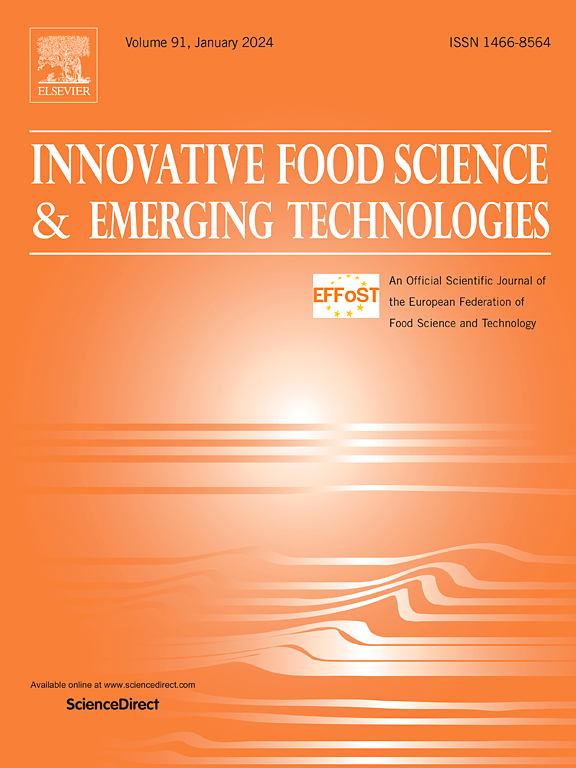等离子体辅助酸热处理诱导玉米蛋白自组装纤颤的机制:纤颤程度的影响
IF 6.3
1区 农林科学
Q1 FOOD SCIENCE & TECHNOLOGY
Innovative Food Science & Emerging Technologies
Pub Date : 2024-12-23
DOI:10.1016/j.ifset.2024.103909
引用次数: 0
摘要
蛋白质纤颤在食品工业中具有良好的特性,在蛋白质改性方面显示出巨大的潜力。但由于玉米蛋白的醇溶性和β-片含量有限,单纯采用传统的酸-热处理方法,玉米蛋白的纤颤度并不理想。本研究采用冷等离子体技术辅助酸热处理,提高玉米蛋白的纤颤程度。研究了不同纤颤程度玉米蛋白原纤维(ThT荧光强度为1358 ~ 2272,命名为PZF1-5)的理化性质和分子结构变化。结果表明,与天然玉米蛋白相比,血浆辅助纤颤使玉米蛋白原纤维具有更多的表面电荷和更小的粒径。经纤颤处理后,玉米蛋白的平均粒径由天然玉米蛋白879.57±155.52 nm减小到最小的123.80±10.26 nm (PZF3)。等离子体处理显著增加了β-薄片和二硫键的含量(p <;0.05),将玉米蛋白由球状形态转化为珠状原纤维。与未经等离子体处理的玉米蛋白原纤维相比,等离子体放电后玉米蛋白中二硫键含量显著增加,达到9.52±0.07 μmol/g (PZF5)。综上所述,等离子体辅助自组装纤颤的驱动力主要包括静电相互作用、氢键和二硫键。值得注意的是,经等离子体处理的玉米蛋白原纤维的乳化能力有所提高,乳化指数与纤维纤维的纤颤程度呈正相关。这些发现为玉米蛋白纤颤提供了有价值的见解,并证明了冷血浆作为蛋白质纤颤支持方法的潜力。本文章由计算机程序翻译,如有差异,请以英文原文为准。
Mechanism of zein self-assembly fibrillation induced via plasma-assisted acid-heat treatment: Influence of the fibrillation degree
Protein fibrillation displays great potentials in protein modification with favorable attributes in food industry. Due to the alcohol solublility and limited β-sheet content, however, the fibrillation degree of zein was not ideal simply through traditional acid-heat treatment. In this study, cold plasma technology was employed to assist the acid-heat treatment to improve zein's fibrillation degree. The physicochemical properties and molecular structure changes of zein fibrils with different fibrillation degrees (ThT fluorescence intensities from 1358 to 2272, named as PZF1–5) were investigated. Results indicated that plasma-assisted fibrillation resulted in zein fibrils with more surface charge and smaller particle sizes than natural zein. After fibrillation, the average particle size of zein decreased from 879.57 ± 155.52 nm (natural zein) to the minimum of 123.80 ± 10.26 nm (PZF3). Plasma treatment significantly increased the content of β-sheet and disulfide bonds (p < 0.05) and transformed zein from a globular morphology to bead-like fibrils. Compared with the zein fibrils without plasma pretreatment, plasma discharge could generate more disulfide bonds within zein as the content remarkably increased to 9.52 ± 0.07 μmol/g (PZF5). Based on the above, the driving force of plasma-assisted self-assembly fibrillation mainly involved electrostatic interactions, hydrogen bonds and disulfide bonds. Notably, improved emulsifying capacity was observed for the plasma-treated zein fibrils, with the creaming index positively correlated to the fibrillation degree. These findings provided valuable insights into zein fibrillation and demonstrated the potential of cold plasma as a supportive method for protein fibrillation.
求助全文
通过发布文献求助,成功后即可免费获取论文全文。
去求助
来源期刊
CiteScore
12.00
自引率
6.10%
发文量
259
审稿时长
25 days
期刊介绍:
Innovative Food Science and Emerging Technologies (IFSET) aims to provide the highest quality original contributions and few, mainly upon invitation, reviews on and highly innovative developments in food science and emerging food process technologies. The significance of the results either for the science community or for industrial R&D groups must be specified. Papers submitted must be of highest scientific quality and only those advancing current scientific knowledge and understanding or with technical relevance will be considered.

 求助内容:
求助内容: 应助结果提醒方式:
应助结果提醒方式:


